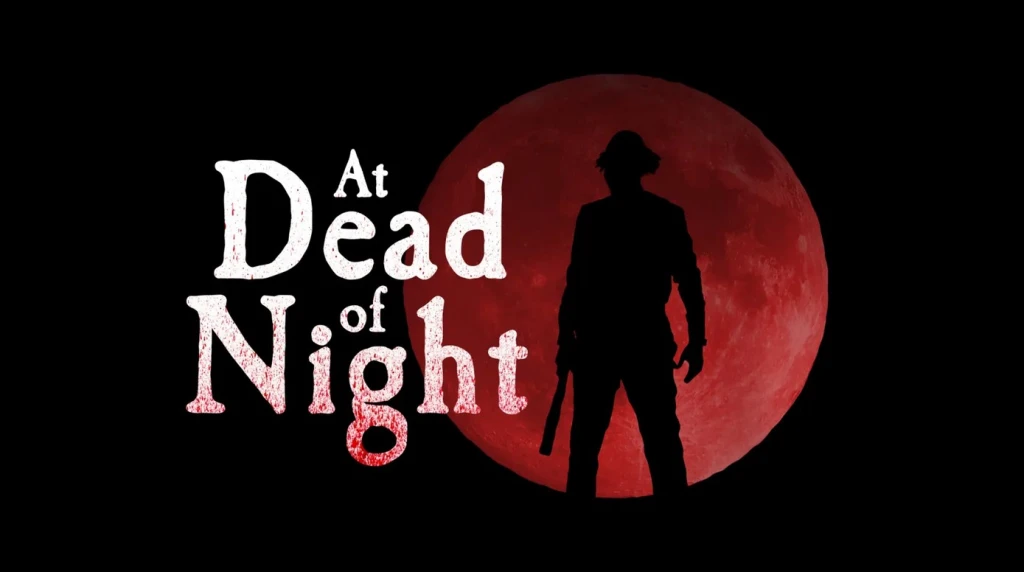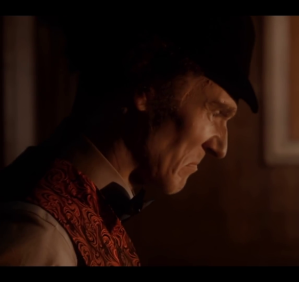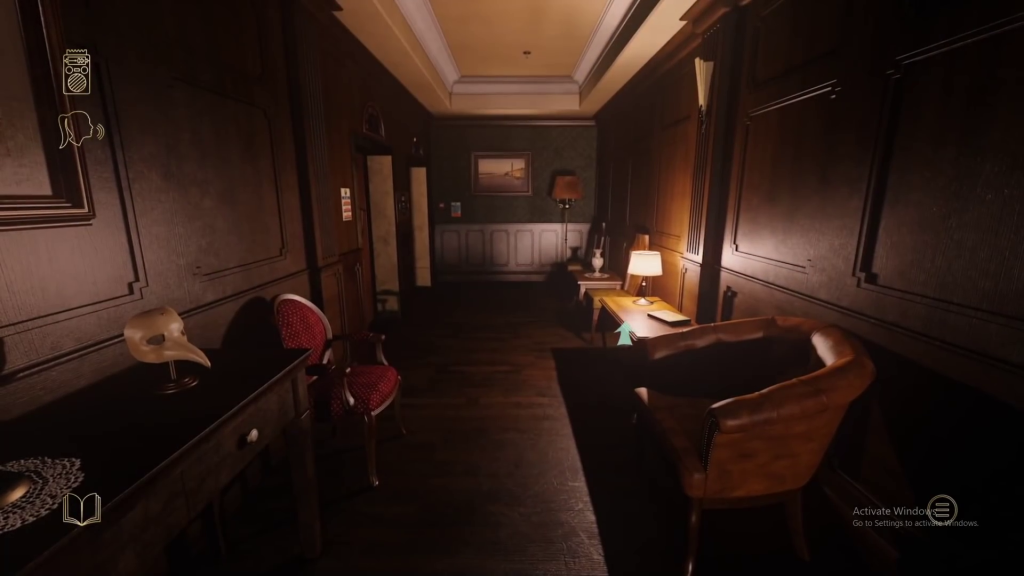Experimenting with blending media can be tricky. FMV games have, over time, gotten a bit of a reputation as being a bit cheesy, fun to chuckle at but nothing to really take seriously. With the advent of high-quality CGI, they can seem a bit like relics of the past, outdated and pointless when better storytelling methods exist for video games.
But then along comes something like Baggy Cat Entertainment‘s At Dead of Night, taking the gaming world by surprise and reigniting an appreciation for the the hybrid media.

At Dead of Night has the player take on the role of Maya, on her way to meet up with friends at the Sea View Hotel. Upon arrival, she meets the hotel’s proprietor, Jimmy, who as it turns out has kidnapped all of Maya’s friends and is holding them hostage, thanks to his alter ego, Hugo Punch. And now he’s coming for Maya, too.
You’d think the game would be all about Maya rescuing her friends from Jimmy’s clutches, and yes, that is part of it, but it’s only part. Much of the game is set up like a live-action point-and-click adventure, with Maya traversing the hotel, using her psychic gifts in search of clues about Jimmy’s past. Most of those clues come from the hotel’s resident ghosts, because this is a horror game at its core. Psychological horror with a supernatural twist, I think is a good way to describe it.
A SHIFT IN PERSPECTIVE

Maya’s investigation leads her to a radio she can use to communicate with the spirits in the hotel, spirits that are all tied back to Jimmy in some way. Figures from Jimmy’s past that slowly reveal their relationship to him through a series of cutscenes, glimpses back in time as ghosts re-enact scenes from their lives. It soon becomes apparent that even from a young age, Jimmy was the sort of manipulate and harm, though why, and what started it all, remains a mystery for a long time.
What struck me as interesting about the ghost cutscenes is that in many of them, the encounter takes place from Jimmy’s perspective. Maya sees the ghosts — or echoes of the ghosts — acting out the scenes, often talking in her direction as though she were Jimmy. Amy, a little girl and the first ghost Maya encounters, is the biggest exception to this, though there are a few others. Whether this was done deliberately or was pure coincidence, I couldn’t really say, but I did find it interesting.
Anyway, while Maya is wandering all over the hotel in search of more clues to Jimmy’s past (and thus, she hopes, to his downfall), she also has to dodge Jimmy himself, who is stalking her all over the place. Audio cues can alert the player to Jimmy’s approximate location, whether he’s close or far away, and when he draws too near, Maya can hide inside unlocked hotel rooms, either locking the deadbolt if she has the key, or hiding inside a bathroom or wardrobe otherwise. Jimmy can enter the room and look around, and often in the beginning he’ll go away if Maya isn’t immediately in sight, but he grows more crafty as the game progresses, faking the player out occasionally by opening and closing the door to make it sound as though he’s gone, when really he’s hiding inside the bathroom, waiting to ambush Maya as she leaves.
If Jimmy catches Maya, he’ll smack her on the head with his trusty baseball bat and knock her out. She’ll wake up in another room shortly afterward, though, with any items she collected now being dispersed to random locations all around the hotel, requiring a search to find them all again. Not the world’s worst setback, though still a bit frustrating, especially when you’re sure you’ve done everything right but Jimmy was being too clever for my own good.
 One aspect I thought could have been done a bit better were the visual sound cues. Now, it’s great that they even exist in this game, because so many games with sound-based cues don’t bother, effectively locking out any player- or audience-base with hearing issues, but At Dead of Night does provide some, informing the player if Jimmy can be heard relatively nearby, or if a ghostly sound is getting louder or quieter depending on where you go. Which is great and all, don’t get me wrong, but it doesn’t do a whole heck of a lot of good if you’re trying to figure out where nearby Jimmy is, and you can’t tell if the sound is coming from your left or your right. I understand that as a game mechanic, just giving players info like, “Don’t take the left hallway because Jimmy’s there,” is going to make things a bit too easy, but for players who are Deaf or Hard of Hearing, visual directional sound cues can be the difference between being able to play a game and not being able to play a game.
One aspect I thought could have been done a bit better were the visual sound cues. Now, it’s great that they even exist in this game, because so many games with sound-based cues don’t bother, effectively locking out any player- or audience-base with hearing issues, but At Dead of Night does provide some, informing the player if Jimmy can be heard relatively nearby, or if a ghostly sound is getting louder or quieter depending on where you go. Which is great and all, don’t get me wrong, but it doesn’t do a whole heck of a lot of good if you’re trying to figure out where nearby Jimmy is, and you can’t tell if the sound is coming from your left or your right. I understand that as a game mechanic, just giving players info like, “Don’t take the left hallway because Jimmy’s there,” is going to make things a bit too easy, but for players who are Deaf or Hard of Hearing, visual directional sound cues can be the difference between being able to play a game and not being able to play a game.
If there was a way to turn on visual directional sound cues in the settings, I couldn’t find it. So if they’re there and I just missed them (entirely possible; I won’t rule it out), then disregard the last paragraph. But for my part, my hearing comprehension issues made some parts probably more difficult than they really needed to be.
IS IT A MOVIE? OR IS IT A GAME?

At Dead of Night is done mostly in live-action, scenes portrayed by actual people instead of people lending their voices to a CGI creation. This is the case with many FMV games, though the biggest difference here is the quality. I was really impressed by the quality of the acting, both from the people you see onscreen to their voiceover work done mainly through the spirit radio.
Much of the game feels like an interactive movie, and I kind of love it. It added to the immersion, the reality of the setting and actors allowing me to really get into the story that was unfolding before me. It wasn’t 100% live action, mind you, as that would have made some scenes impossible, but the blend of the real world and CG was done so effectively that none of it felt jarring, all of it felt like it fit together cohesively. That’s honestly not easy to do, and I’ve seen so many pieces of media lean too heavily into CG at the wrong times, only to have the end effect look a little silly. Not so here, and that’s worthy of some praise.
 I won’t say this game has no jump scares. There are plenty, though admittedly there are also some subtle cues that you’re about to get jump-scared, if you know what to look for. Ghost scenes will often sort of sneak up on you, the scene beginning when you turn a corner or turn around, and BAM, suddenly there’s a person there when there most emphatically wasn’t a moment ago. And with Jimmy on your tail the entire time, it’s easy to think that you’re about to get whapped on the noggin again.
I won’t say this game has no jump scares. There are plenty, though admittedly there are also some subtle cues that you’re about to get jump-scared, if you know what to look for. Ghost scenes will often sort of sneak up on you, the scene beginning when you turn a corner or turn around, and BAM, suddenly there’s a person there when there most emphatically wasn’t a moment ago. And with Jimmy on your tail the entire time, it’s easy to think that you’re about to get whapped on the noggin again.
Lights tend to flicker in the vicinity where this will happen, which the game does inform you of early on. But many’s the time I got to an area with flickering lights and saw nothing strange, only to turn around and get a fright because the scene was set to play behind me, and I hadn’t expected it.
Fortunately, with the exception of Jimmy, none of these jump scares are damaging or involve set-backs to the player, which is more than a lot of games with jump scares can claim. I’m not a huge fan of jump scares, admittedly, but given that this is a horror game, I can’t say I’m surprised or annoyed at their presence.
More like annoyed at myself for falling for them.
CONTROVERSIAL TOPICS

I’ll be frank: this game deals with a lot of controversial and touchy subject matter, which players would do well to be aware of prior to playing. The most obvious and immediate topic is Jimmy himself, and his alter ego, Hugo Punch. Now, the game does provide some information about dissociative identity disorder (DID), which Jimmy has, but that condition has been controversial for decades now, with many experts denying that it even exists in the first place. Players might be more familiar with the condition’s older name, multiple-personality disorder, but in a nutshell, DID is the term applied when someone has multiple different personalities residing in the same body. It’s often seen as a response to trauma, with the individual’s mind trying to shelter themselves from horrific realities by creating another persona that can move to the forefront, allowing the body’s primary personality/identity to sort of “take a break” and not deal with things for a while. Or perhaps idealized identities that represent who the primary wishes they could be, or identities that are almost “frozen” at a certain point in development or in time, usually before the trauma occurred. Most people with DID do not have psychotic alters like Huge Punch, however, and it’s extremely important to remember that.
But even aside from the controversy of “Is DID even a thing?”, At Dead of Night also deals with child abuse, suicide, torture, drug misuse, kidnapping, and multiple kinds of violence. It’s easy to handwave all of this by saying, “It’s a horror game, of course it’s not going to be all happy and innocent,” but there’s something about the realism of this game that makes a lot of the difficult topics hit home in ways that don’t always work in other games. For all that At Dead of Night involves ghosts and the supernatural, the fact that all of the ghosts died in ways that are very realistic, the fact that Jimmy’s trauma stems from childhood abuse, means that there’s a degree of realism here that isn’t found in, say, a game in which there’s suicide, torture, and kidnapping because of a cult dedicated to raising demons, for instance. Maya and her friends stumbling into this situation is entirely plausible, something that could happen to anyone at any time, and that lends a sense of credibility to the whole situation, even the supernatural elements.
So, player be warned, essentially. In playing this game, you’re going to be confronted with some very real — but not at all gory or bloody — depictions of some very upsetting things, and it’s worth taking the time to consider whether any of these topics might trigger traumas of your own.

Overall, I really enjoyed At Dead of Night. I had a couple of issues with it, as previously mentioned, but in general I found the story compelling, the setting and atmosphere fantastic for building tension, and the simple point-and-click style interface made it easy to get to grips with. There’s a reason this one has been making the rounds on Let’s Play channels, and if you’re looking for a visually-impressive horror game that relies more on psychological thrills and a slow-burn setup than on monsters and mayhem. It was as fun for me to play as it was to watch others play, and even if I wouldn’t say it has high replay value, it’s still a game I’d recommend playing once, especially for fans of horror games who are looking for something a little different.
Leave a comment